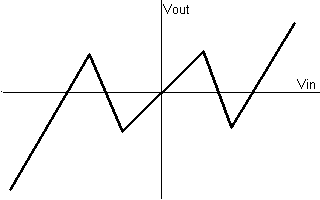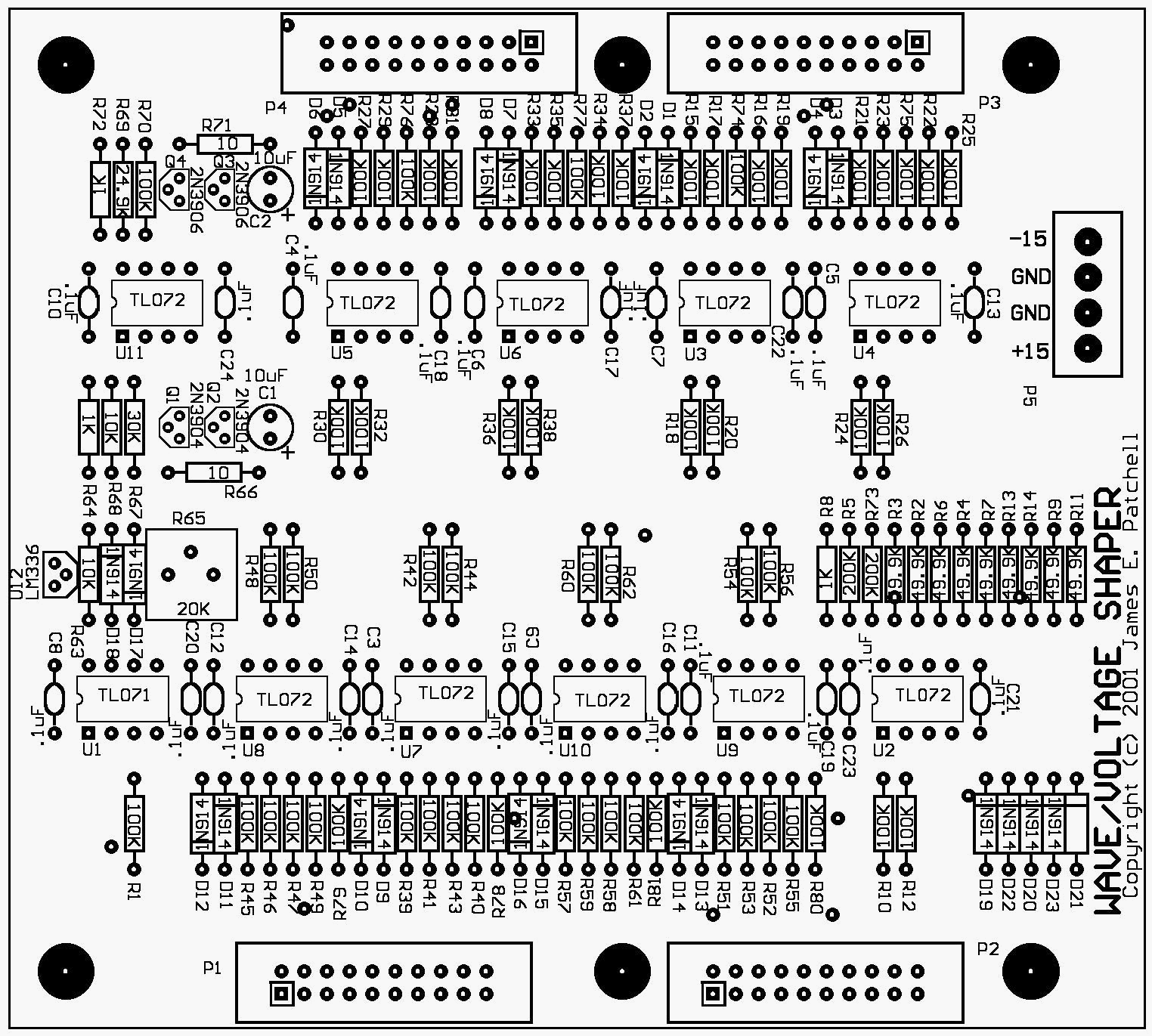
Last Update 1-1-2002
The waveform/voltage shaper has many uses. It can be used to turn a triangle wave into a sine wave. I think it might even be able to turn a sawtooth into a triangle wave or sine wave. It can be used to make any waveform more harmonically rich. It can be used as a limiter (very harsh limiter, but limiter none the less).
It can also be used to map control voltages, for
say, a vocal filter. It can be used to make ADSR envelopes more
interesting.
It has quite a few uses.
Shaper MP3 demo file
Guitar MP3
demo file
What this file consists of is a moderately low
frequency
triangle wave that is fed into the input. The amplitude is
increased
and then slowly decrease. The transfer function looks something
like
this:

What this function does in the time domain is first doubles, then tripples the frequency, as the amplitude increases. Has an interesting phasing sound, which surprised me. I am kind of wondering what a guitar would sound like through this.
The circuit is quite simple. It is basically a set of ideal diode circuits that are used to set break points. There are four ideal diodes for the positive portion of the signal, and four ideal diodes for the negative portion of the signal. One additional circuit allows for the adjustment of the gain and offset of the original circuit. These 9 signals are then summed together to make up the output.
If built to it's fullest, there would be 18 pots to adjust the output. This is a lot of panel space. Plus, each breakpoint has an additional input so that you can modulate the breakpoints. The there is the input and output. This comes to 10 jacks. As you can see, this module will take up a lot of panel space. Which is probably why you don't see many around, I suppose.
The PC board has been implemented so that no wires need to be soldered to the board. The power supply is a four pin connector that should be MOTM compatable. All of the other signals come off of 20 pin IDC connectors. Except for one pair of pins, there is a ground between each signal. You should be able to use either ribbon cable or crimp pin (my first choice, if you have a crimp tool) connectors.
Adjusting Module
This is the tricky part. If you want to implement a particular transfer function, you will probably need a scope to do this. Put a triangle wave into the input of the module. Put the "X" input to the scope on the input, and the "Y" input of the scope on the output of the module. You will now have a plot of the Vout/Vin characteristic of the module.
Now, saying this module is a little bit tricky to adjust is like saying a skunk stinks just a little bit. Here is what I learned after bring my first one up. I will be refering to parts on one of two schematics. The shaper module (SM), document number 100-1002, and the front panel schematic (FP).
1. The position of the GAIN pots is extremely important. As well as break points.
2. Refering to the front panel schematic (FP)
adjust
the following pots to their 0 volt position. On my module, 0
volts
is fully CCW.
R1(FP),R5(FP),R9(FP),R13(FP),R3(FP),R7(FP),R11(FP),R15(FP)
3. Refering to the front panel schematic (FP), adjust the master offset pot to zero volts. R17(FP). This will be the center of rotation for this pot.
4. All of the gain pots are set up so that at the center of rotation, the gain is 0. However, in order to be really sure of this, we really need to use an osciliscope to be absolutely positive. Feed a triangle wave into the input. 100Hz is a good frequency to use. Connect the X input of your scope to the input. Use the Y input of the scope to probe the following points and make the following adjustments. IC pin numbers will be specified as follows <U number>-<Pin number>, so U3-1 means U3 Pin 1.
Probe U3-1(SM) and adjust R4(FP) for a flat line
(horizontal). Notice as you adjust R4(FP), at zero volts it will
break with a slope controlled by R4.
Probe U4-1(SM) and adjust R8(FP) for a flat line.
Probe U5-1(SM) and adjust R12(FP) for a flat line.
Probe U6-1(SM) and adjust R16(FP) for a flat line.
Probe U7-7(SM) and adjust R2(FP) for a flat line.
Probe U8-7(SM) and adjust R6(FP) for a flat line.
Probe U9-7(SM) and adjust R10(FP) for a flat line.
Probe U10-7(SM) and adjust R14(FP) for a flat line.
Probe U2B-7(SM) and adjust R18(FP), this is the master gain, and ajust for the flatest line. How flat the line will be will depend on how good the above adjustements were. They do add up, so the line might not be quite flat.
Now, you are ready to start playing with the module. Take it slow and easy until you get used to it. Things can get really messed up if you make a wrong move. You will probably always need to use a scope to set the knobs up.
You can also do it by ear. This is probably
good for audio signals anyway. You are more concerned about what
they sound like rather than look like. (This was a line I originally
put
here, and this is BS! now that I think about it, but, who knows).
Here are the more important files you will need to build the wave shaper.
PCB Schematic
Front Panel Schematic
Bill of Materials(Pdf)
Bill of Materials (Text)

Parts placement on the printed circuit board.